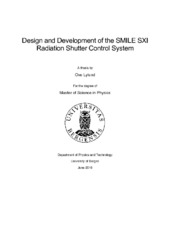| dc.description.abstract | This thesis concerns the design, implementation, testing and verification of the radiation shutter control system, an embedded, microcontroller-based system, to be used in the Solar Wind Magnetosphere Ionosphere Link Explorer (SMILE) satellite. SMILE is a scientific space mission for exploring the Earth’s radiation belt, ionosphere, and magnetosphere. It involves several institutes where European Space Agency (ESA) and the Chinese Academy of Science (CAS) are the primary contributors. The SMILE satellite is expected to launch towards the end of 2021 and will follow a highly elliptical orbit, reaching almost 128 000 km over the northern hemisphere. SMILE carries four instruments, including the Soft X-ray Imager (SXI). The SXI features a sensitive soft X-ray detector, built for detecting low energy electrons. The orbit traverses the Earth’s radiation belts when the spacecraft is near perigee. The radiation belt is a highly radiative area that the SXI detector cannot handle, and therefore, must be shielded. The University of Bergen is responsible for the development of the radiation shutter, which consists of the Radiation Shutter Electronics (RSE), the Radiation Shutter Mechanism (RSM), and the control system provided by this thesis. The radiation shutter will significantly reduce the SXI detector’s exposure to radiation by covering its focal plane during the crossing of the Earth’s radiation belts. In addition, if necessary, it will shield while performing spacecraft manoeuvres where the sensor is prone to stray light. This thesis describes the implementation of a well-designed, generic and modular control system which accomplish all operations required to protect the detectors. The system holds a custom interrupt driven scheduler which guarantees execution of both soft and hard real-time tasks within the timing constraints. These tasks include communication with the SXIs’ control unit, collecting HK-readouts from sensors, and safely operate the shutter through a stepper motor. Furthermore, a flexible stepper driver software is developed with emphasis on predictable stepper motor operations, efficiency, and in-flight adjustable features. The system has been methodically tested through software analysis and hardware measurements. The tests confirmed that all tasks were completed without any timing violations and the driver software successfully drives the stepper motor. | en_US |
